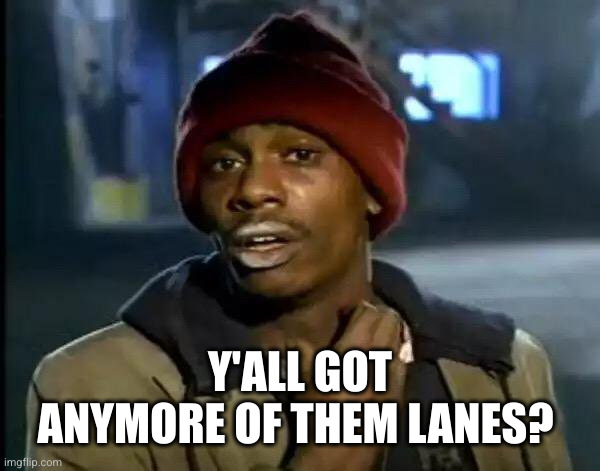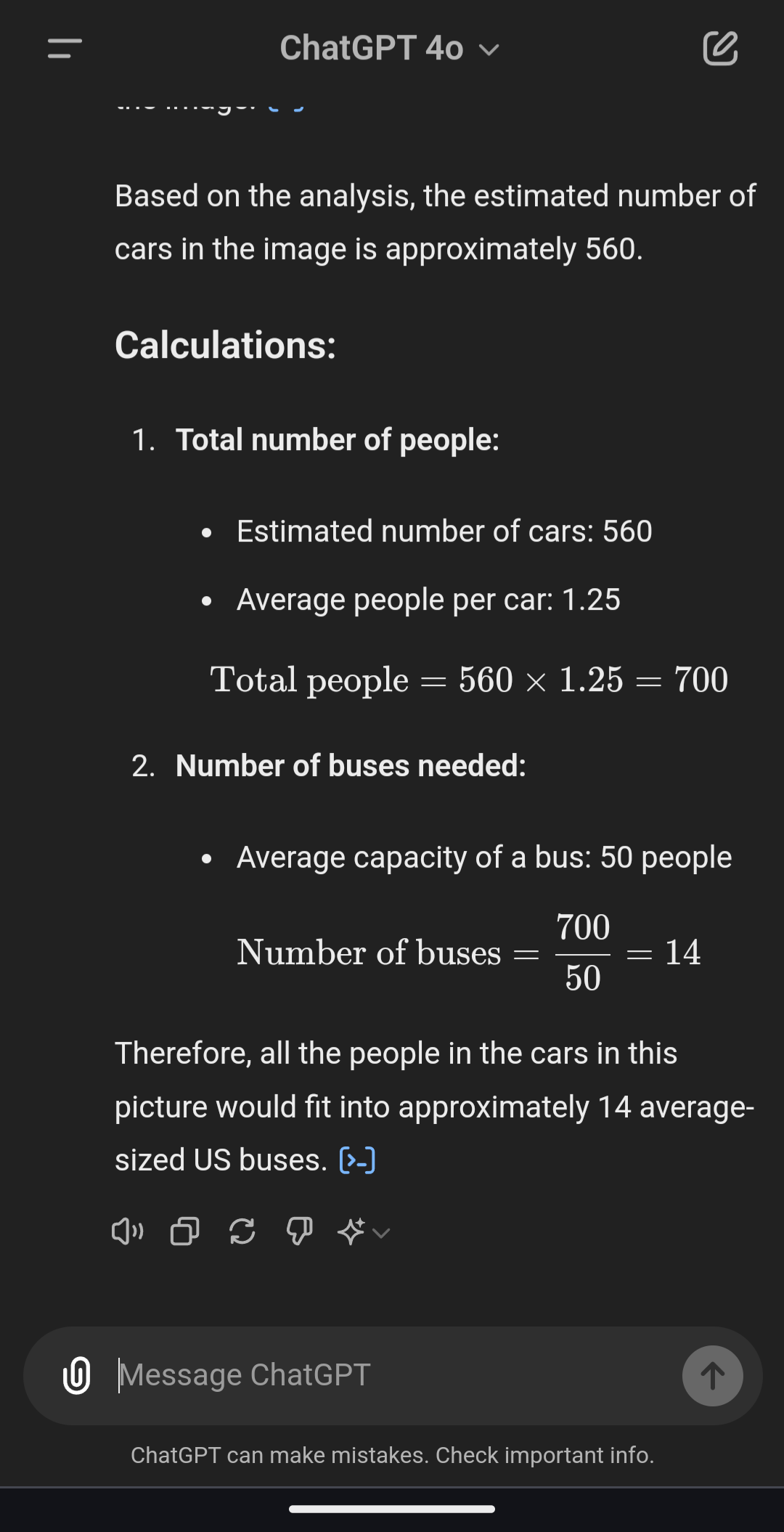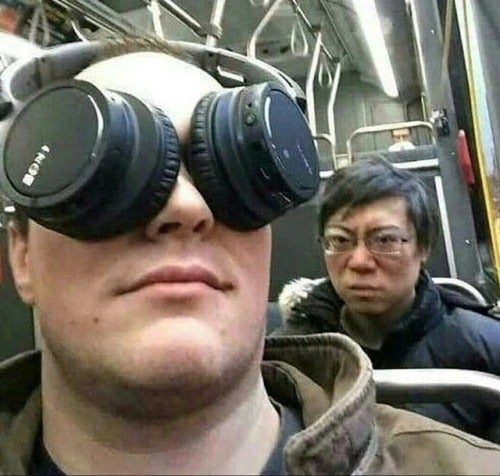One more lane, bro
I swear bro, just one more, please
Worked every time so far, I swear!
WE’RE GONNA FIX TRAFFIC, FOR REAL THIS TIME

Just one more and it’ll all be fixed, trust me bro
Double it and pass the problem to the next generation
There are 2-4 HOV/toll lanes in the middle depending on where you are in the city. I only see 2 in this photo, and they aren’t called out in OP’s title.
Everybody in this photo could fit in like 4 buses
See, this is what AI was actually made for. 14 buses.

Always remember LLMs are trained to sound correct to the human mind, not be correct.
^ This guy is an LLM. Take everything he says with a grain of salt
Well done
For a small segment of the trip. The problem with public transportation is that all these people are going to different locations and a bus being more efficient for 50% of the travel doesn’t really help you for the other 50%
The problem is not with public transportation, the problem is that the area surrounding this highway was designed so that more cars and more lanes were the only possible solution.
Cars create problems that only cars can solve.
Edit: and to add more context: those 50 different locations are all separated by massive mandatory parking lots which make them miles apart from each other when they could likely all be contained in the same building in front of a single bus stop.
Unless there’s another bus for the other 50% of the travel. The point of a public transportation system is to be just that - a system. To get from anywhere to anywhere else.
Where I live this will cause what would be a 15 minute car ride into 1.5 hours of hopping on different busses and then walking 1/2 mile to your destination on either end. I don’t have a problem with effective public transportation but outside of major population centers like Manhattan, I haven’t seen one that really works all that well here in the US.
Well, that’s the thing you could have it if you invested all the money that currently goes into highways. The amount of money is always limited (everybody hates taxes for a reason), so building large quantities of both is impossible.
Roads are always going to cost more in the end, but they’re easier to build incrementally. Boiling the frog situation.
Even if policy of your local government changes (which is at least a little up to you) you will still have to suffer the current situation and keep driving for a while before a better system is built. But that’s no reason to throw good money after the bad.
It wouldn’t be a 15 minutes car ride once the traffic jams start. The point of public transport is not to completely replace cars, but to provide an alternative for people. A good public transport system will cover most destinations so people won’t have to worry like you do about reaching your destination. By doing so, it will reduce cars on the road which will also benefit the people who do need to drive to where they want to go.
Eventually it will be robotic cars doing the last mile on systems like that. Most trips will still be in individual cars or maybe minivan size things, but people who are following very popular shared paths will be asked to step into a bus. When it’s all roboticized, we won’t need stations for that though. Cars will be able to match bus speed and passengers can step from A to B while the whole thing’s in motion.
Next time on Beyond 2000, we’ll talk about decentralized DNS
As someone who has lived alone for eight years using only public transport in an area with excellent public transport, I can tell you that you are both right and wrong.
You are right in that if there is just one bus line, then it would only serve a small subset of people in this photo.
But if you only make one bus line then the public transport system is doomed to fail.
A good public transport system will have multiple lines converging to the same interchange, and in the opposite direction it will have multiple lines departing the same interchange, following the same route and branching off when needed, this way you have added capacity and redundancy at the start of the line, and it gets reduced as the need is reduced.
Then add lines that are circles in higher density areas, this means that no matter the direction all passengers can get on all departures, you csn also quickly add capacity by adding busses that goes in alternating directions.
All of this means that travellers can define their own route along different bus, train, tram, metro and ferry lines.
Public transport is not ment to be point to point, it builds a framework where people decide what parts the want to use.
Cars are just more precise in space and time. In a car you go from your origin to your destination, within lot-to-door distance, and you go exactly when you want to.
With public transportation, you travel a block or two to enter the system, arrive a block or two from your destination, and you can only leave at certain intervals.
At my last job the commute was:
10 minute walk to the bus, 50 minutes on the bus, walk across parking lot to office.
The same commute by car was 15 minutes.
You are technically correct, but you miss the great part of frequent departures in a public transport system.
During peak hours I have a buss departing my local stop every 10 min, it takes me 7 min to walk to the busstop, when I arrive to the metro my train usually departs within less than 5 minutes, it takes 2 min to walk down to the platform from the bus, if I miss the train, the next train will depart 5 min later. When I need to switch lines I just walk over the platform and my train will usualy arrive with in 2 min, though it is not unusual for the train to be at the platform and I have time to cross the platform.
When I then get to my destination I exit the metro and walk 100m to get to my office, my desk is actually just above the entrance/exit of the metro.
Obviously this is under optimal conditions, but it isn’t that uncommon either.
When you have public transport departures that frequent, you don’t really have to took at the timetable, you just walk down to the bus stop and with in minutes you are on the bus.
There are also dedicated buslanes along 97% of the way I take the busses, so traffic jams are seldom an issue.
And should there be an issue with my normal bus, I can walk 15 min to a different bus stop with other busses, or I can walk 20 min and get to the train/bus station and get on a train or yet another bus.
This is fine since large disruptions are quite infrequent.
Oh sorry, 20 buses to cover all the sectors these people are going to then.
So what?
Living in a city with actually good public transit, it is used to achieve exactly that. To get any one passenger from any one point within the metropolitan area, to any other. To work for everyone, even though every single person is starting from a different point, and going to a different destination.
It doesn’t matter where you’re going or from where. There is a public transit stop nearby at both ends.
The fuck do you mean “a small segment of the trip”? I share this city with a stupid number of other humans, only a small number of which I go to work with every day, yet a significant portion of of the entire city population travels to work, entertainment and shopping, using the exact same transit network.
Your trip may overlap with a varying number of entirely different individuals along each segment of the route, and at each end it might just be you walking a few dozen meters… But come on! The fact that it adds up is beyond obvious!
Your argument is only valid for mass transit, that isn’t actually mass transit.
And as density goes up (read less roads and carparks), the overlaps INCREASE and the whole thing gets more efficient.
There is a train station in Tokyo, that serves the same number of people every day, as there are citizens in my entire country.
Can you even imagine what a highway interchange that could serve 5 million people within 24 hours would look like? No, because it’s a physical impossibility.
The only reason the number can get so high, is because transit systems consolidate travellers even when they aren’t going to the same places.
I think I may have been to that train station.
I walked through a place that, at first, I thought was a regular metro station. But then it just kept opening up more and more, into more and more spaces. It was like a mall. I guess it was like an airport terminal. Businesses all over.
When I finally left it, I thought I was underground and then turned a corner and there was open daylight, no door, not even a wall just like the opening of a huge cave.
95% of Londoners are 400m or less from a bus stop. The bus service suits everyone for any journey. And then we have trains and the tube. There’s never a need for a car no matter where and when you go.
London wasn’t developed after the automobile. Houston’s metroplex covers a much larger area with a much smaller population, which makes London’s solutions much less practical.
The closest bus stop to someone in Alvin or Bellville may be 20 miles away, and they’ll have to change busses 7 times to get where they’re going.
And to put numbers to your points, London’s population density is 14,600 people per square mile, while urban Houston is only 3,340.
And if you want to talk about the broader metropolitan area, then London goes down to 3,900 people/sq. mi., which is close to Houston’s urban area. However, if we look at Houston’s equivalent to that the density drops to 862/sq mi.
Also, London’s metro is 3,236 square miles. Houston’s is 10,062.
Anyone who compares these as equivalent is disingenuous or ignorant (not necessarily maliciously so, but likely just unaware or oblivious to the massive sprawl that Texas cities have).
I haven’t seen anyone try to claim they’re equivalent yet
That’s cool that Londoners all live so close to each other and have a city built around public transportation. Unfortunately as someone who lives in Texas a car really us practically mandatory. Our Urban sprawl is large and it’s not something that can or will be easily fixed even over multiple lifetimes. To give an idea of what it is like over here, the nearest grocery store is a little over 3 miles (~5 km) away from where I live. There is no bus route within a 2 mile (~3km) area of me that provides transportation to that area.
The public transportation we do have is lacking in availability, accessibility, and coverage. and while there are ongoing efforts to update it. These updates primarily apply to the inner parts of the large cities and rarely cover the urban living areas where people actually live at. And these living areas are frequently very far away from where public transportation is available.
The main problem is that Texas cities are just too expansive in size for public transportation to currently be effective. This isn’t even factoring in how long commutes would take to be for some people even if they where somehow magically available tomorrow.
For example, many of my co-workers on my overnight shift live far enough away that commuting to work in a car during the dead of night on an empty highway road where they drive 75+ mph ( 120+kph) still takes them an hour or more to arrive to work daily. This is consider a common and even somewhat normal commute time and distance in Texas. If they had to take public transportation they would be looking at an over 2+ hour commute everyday at best. So that is not really a viable option for them.
Im really happy that Europeans have more dense cities and don’t have to deal with the same problems we have. But it honestly gets tiring hearing everyone say public transportation be the solution for everything in Texas. Yes it would very much help and efforts are being made. But due to how Texas cities where laid out and planned with urban sprawl in mind multiple decades ago before even my grandfather was able to give input. We can no longer have public transportation be a viable option for a large segment of the people who live here.
What Texas needs is both public transport AND better highway road planning, for example more exits and on ramps, more alternative routes to free up congestion on major feeder arteries. Not more lanes on the same congested routes, off ramps, feeders, etc.
Sorry for the rant, I just fucking hate the traffic here and it’s causes have become my mini soapbox of annoyance
Well, I understand that. But the change should start somewhere and somehow, right? I can only provide you with examples how the public transport works elsewhere, but you’ll have to do some ground work yourself, like advocating for public transport, voting for more responsible government, etc. Or… Make America Great Britain Again!
That’s why frequency is one of the most important factors for public transportation.
And good coverage.
They’re all up there. I’d probably go with
- Safety
- Frequency
- Availability (operating hours)
- Coverage
- Cost
Is that Cost in terms of building the system, or the time cost of using it?
Utility (or Time Cost, basically) seems like it should be up there, and I think that’s what you’re getting at with Frequency and Availability?
I think the time cost of using the system is the most important factor in designing a transit system.
Because every human has a finite amount of time. It’s our most precious resource.
Honestly if you’re willing to count a premature death in terms of a life containing X number of hours, I think that Safety factor can be put into perspective.
Obviously there’s also the enjoyability factor. A five minute trip during which your sunburn gets scratched mercilessly might not be better than a 15 minute trip in a jacuzzi.
But barring huge differences in comfort countering the effect, Time Cost of using should be the main thing, since everyone’s time is valuable.
Cost of using it
You know, buses… They make more than one stop.
And that accounts for why they take so much longer than a car to get you from the same point A to the same point B.
All of that, for a traffic jam. Imagine turning 4 lanes in a train track carrying 500 person every 5 min in both directions and one lane in a bike lane. It’s still 20 lanes for car, but you suddenly have decent public transport which would be safer and faster than that gigantic traffic jam
Or just a decent bus system. You could replace 50 cars on that highway with a single bus.
It’s always first and last leg in Texas that kills this stuff.
The only affordable housing is far enough outside the city that you basically have to own a car because there’s not enough density to have bus stops.
And going to a park park and ride following by waiting on the bus adds another 30-40 minutes to the commute and gets your car broken into 3 times a year, so nobody uses them.
The real solution is to mandate allowing remote work for positions where it is a viable option.
I commute 4 hours a day for a job where I log into a computer and do all my work online. If people like me were allowed to work remote we’d have more time with our families, traffic would be reduced, and housing closer the city would get cheaper for those who DO need to work in-person.
One train! A single train track solves all of this. No need for two. Just one. In the picture you don’t see more than 500 or so people and that fits in no more than 5 modern train cars, with toilets, refreshments and other amenities. And it moves faster.
Yeah, well, many people are deeply stupid. And selfish. And racist. But I repeat myself.
Personally I think anyone who goes like “I don’t want to ride a train I might have to sit next to a black person” should be dealt with more assertively, but I’m not in charge.
THAT’S MY AMERICA 🇺🇸 🦅🔥🔥🔥 ONE MORE LANE DOESN’T FIX IT MY A$$ LOOK AT THIS AND TELL ME IT ISN’T WORKING 🇺🇸🇺🇸🦅🔥🔥🔥🦅🦅
Anything but a fucking train…
Coincidentally they form train-like structure, without all the benefits.
And quintuple the emissions
Yup. Trains are stupidly efficient.
Soooo like for profit health insurance? Murica
I hate cars and highways so much.
I wish we had good mass transit like Europe.
Everyone always disparages the cost of public transport but how much does it cost to maintain these highways every year? A few dozen/hundred billion dollars across the country?
In USA they fund maintenance by developing the sprawl. So they are stuck in this circle where if they don’t develop, they can’t maintain, but developing means more surface to maintain, etc.
Also how much supposed leasure time is wasted sitting in all those cars, making the people frustrated, sick and unfulfilled?
they’re not really maintained much anymore other than minor stuff. even that costs tons of money and is of minimal benefit for job security of departments doing it. you’ll all be dead before any major development or changes occur. and even if they decided to do something major, the construction of it while you wait for it to be done over the years will make transportation even more unbearable for those years.
China’s mass transit is better. Probably we should just hire the Chinese to construct a national bullet train network in ten years like they did in China. But wait, we can’t do that because that threatens the profits of the bourgeoisie, who are the true rulers of amerikkka. Oh well, enjoy your eight hour commute to make your bosses richer!
Tofu dregs. You should look that up.
China also kinda just forces anyone out who’s in the way. To build any new infrastructure the US ends up getting slowed down to a crawl because of red tape and beurocracy. Land owners have a lot more rights in the US.
Unless the landowners are Black or Indigenous. I don’t recall euro-kkkolonizers asking their opinion about colonization either in the seventeenth century or today.
I’m not talking about history. I’m talking about the US today.
I’m not taking sides really, but I just want to point out that the US very much DOES still do shit to bipoc communities regarding infrastructure and construction and housing.
They will run a new highway right through a neighborhood. And sure, they offer to buy up the land first usually, so that’s nice I guess, but they don’t pay well for it and if you don’t move they just take it anyway. Rail lines run through lower income areas. Highways too. There are “easements” and “imminent domain” legal fuckery that they use against bipoc people mostly too. If it’s a rich neighborhood they go around, if it’s poor people tough luck to them.
Residential can also get rezoned to commercial and force everyone out.
There are LOTS of legal and quasi legal things that are done all the time here. But even the legal ones are often ethically/morally wrong.
So there’s that.
How can you separate one from the other? History doesn’t just begin and end at the convenience of white supremacists. When did the colonization end, for instance? All the euro-kkkolonizers are still here, they just changed their flag and started sending their taxes to DC instead of London.
These “euro-kkkolonizers” were all several generations ago. Maybe you want to pretend nothing has changed, but things have gotten significantly better since then.
I won’t pretend we don’t still have problems. People of color are still statistically lower income, and they’re still affected by all the same capitalist problems that come with that.
The problem is also not the same across the country. Every state has their own top issues.
Which corporate CIA source should I use to excuse the nazis who run the USA?
Japan pretty much has it figured out. Bunch of trains, slow or fast, fancy or frugal. Whatever fits you there’s an option. You can get a Pikachu train with a shop and children’s playground if you want to.
Counting the service road is kind of cheating. In built up areas in Texas they’re de facto city streets that happen to exactly mirror the freeway. They have intersections, lights, businesses, etc.
Yep. Texas does that because of a state law that says any landowner with property adjacent to a highway has a right to access that highway.
If I count the roads off the sides, on ramps and off ramps, etc, the highest I can get is 18 lanes. Is this the photo of where it’s 26 wide? I can’t seem to find it.
I can get to 22 in the foreground of the pic with some lanes underneath others with the flyover ramps.
Lol, the title even says only 20 with 12 main and 8 feeder lanes.
Fwiw, feeder lanes probably shouldn’t be counted in Texas because they’re basically glorified city streets. Businesses can have entrances and exits on frontage roads, so there’s not really anything special about them except that they have a slightly higher speed limit (50~60mph vs 40~45mph) and they have immediate access to the highway.
The feeder there is also almost certainly 45. So not really any faster than normal stroads.
I was going to ask if they count the frontage roads as part of the highway in TX. Because that’s not right.
And traffic STILL sucks in Houston
This is why traffic sucks. Super highways don’t reduce traffic, they create it.
I’m not disagreeing necessarily (I know nothing about city planning), but wouldn’t a smaller highway just force people onto the side streets and city roads? How does a superhighway make traffic worse?
Most people will think traffic behave like water that you need to send through a network of pipes. It is not, traffic is made of humans and humans reactions will make traffic behave wildly differently than waters in pipes.
- Some people and businesses will move next to the new highway for its supposed ease of access, creating traffic
- some people might change their habits and go shopping to this place instead of that place, or getting a job far away from their home (or a home far away from home)
The exact reasons for the increase in traffic is complex and my example could be totally off. But we don’t need to know the exact reason for the increase in traffic, we know it happens because it has been observed on every road enlargement projects in the last decades.
There are some good videos by notjustbikes on this topic, iirc the main problem is that big streets make people want to drive more which makes everything more crowded
Ah, bikes. Driving is a necessity. I’m not going to commute 30 miles to work on a bike, and I’m not going to haul a pallet of drywall on a bicycle.
Off-road bikes are great, and they’re good machines for exercise. Bicycles should not be allowed on public roads. They’re a hazard.
The bicycles aren’t the hazard, the cars are.
In europe a few countries have city centers where you aren’t allowed to drive your car and some countries have seperate paths where bikes can ride.
Bikes are way better for the environment and trips around 5-15 km can easily be done with a bike without having to pay for gas or insurance etc.
Bikes also help you do excercise without having to waste time because you are doing the excercise while travelling somewhere.
Bikes and public transport are so much more efficient than cars
Tbf there’s assholes who behave recklessly in traffic on every mode of transportation. I’ve been run into by a bike twice in the past few years. But guess what, if we built proper infrastructure for them, they wouldn’t choose the sidewalk in order to protect themselves from cars. Also, the choice between whether you’d rather a bike or a car runs into you is pretty obvious.
the choice between whether you’d rather a bike or a car runs into you is pretty obvious.
No doubt. I pick car every time. Listening to the douchebag cyclist whining after the accident would be too much for me to bear.
Bicycles ARE the hazard. If your vehicle of choice isn’t able to reach and maintain the speed limit, then you are a hazard to everyone else on the road.
If you really don’t want to drive a car, buy a motorcycle.
How are they a hazard if they can’t even do damage to anyone, the cars however weigh multiple tons and would instantly kill anthing smaller than a car if hit at something above 30kmh
If you had access to good public transport you could take a train for those 30 miles and relax, work or read instead of wasting time being focused on traffic. But if there’s too much supply of roads built for the purpose of everyone driving their car everywhere, there won’t be much demand to build something like that.
Biking and walking can then be for mid and short distances, respectively. But both will be dangerous unless there’s proper infrastructure for that. And again, not happening until they stop the over supply of roads.
And for hauling the dry wall, yes, use a car. Imagine how much nicer traffic and parking will be if most commuters who aren’t transporting big loads aren’t in private vehicles.
If I had access to good public transport, I still wouldn’t take it. Driving a car gives me the freedom to come and go as I see fit. There’s no waiting for a bus or a train to show up. Not to mention, driving my car, I’m not forced to sit next to a meth addict on their 5th day awake and third week without a shower.
The problem is that the infrastructure doesn’t exist, and introducing it is cost-prohibitive for large parts of the US. I would love to be able to take a train from my small town to the nearest metro area 30 miles away and then take a tube to a block away from my destination–but that’s just not going to happen in my lifetime, because the city can’t afford to install a subway, and the auto lobby won the war against commuter rail before I was born.
Could it be better? Sure. Might it become better? Maybe, but probably not in my lifetime.
In the meantime, people are de facto dependent on cars. Destroying infrastructure necessary to support the reality of how people must, through no fault of their own, travel punishes the traveling public without addressing the actual problem.
If we’re going to transition to better transit infrastructure, we first have to build the better infrastructure–and pay for it by
eliminatingunseating political opposition. Only then can we dismantle these kinds of monstrosities without disenfranchising the people who depend on them.Yes absolutely! It’s a systemic issue and there’s no reason to blame the individuals who take cars because they’re literally not provided an alternative. It’s so fucked that you literally can’t do anything in much of the US if you can’t afford a car.
And of course it’s absolutely critical to start providing an alternative before dismantling existing infrastructure, fucking people over even further. It doesn’t have to start with a big rail line, even local buses and bike lanes and safe side walks within the small town will help a lot in reducing short car trips, such as to the shops or to school.
But for anything at all to happen, there will have to be enough problem in favour of traffic reform, and they’ll have to be loud. The car lobby is a huge opponent. But in local politics, like on a town level, they don’t have as much of a say. Maybe, just maybe, small change is possible
I know none of this will happen over night, but fingers crossed you’ll get to experience a better future in your lifetime.
It’s more the political opposition than the cost, rail used to be the de-facto long distance transport and it worked very well.
Rail still hauls a lot of freight, but in many areas people no longer enjoy the benefit of rail transport.
Your particular commute might not be feasible without a car, but many are. Adding bike infrastructures allows those who can commute by bike to do so, while freeing space on the road for those who can’t…
Let’s flip the equation here.
If driving wasn’t an option, you wouldn’t live 30 miles away from your job. Driving was an option, so you did and so did your neighbors. More neighbors move in, more cars, more traffic, more lanes, more neighbors, more cars, etc.
Alternatively, you move closer to work in a town with half decent sidewalks and walk or bike in. Bikes and people take up much less space which allows things to be closer together.
And yes, cars are necessary for hauling large objects over long distances, but how many vehicles in this photo do you think are carrying more than just people?
Building larger highways always encourages more traffic. For a better explanation, check out this video by Adam Something. His youtube channel has a lot of interesting videos about transportation infrastructure.
If it helps you can imagine the side streets and city roads as unused additional lanes.
You can turn the entire freeway system into a grid and it will still suck - Los Angeles
Los Angeles also has a higher population than 50% of the countries on the planet.
An anecdote fully lacking in relevance on account of there being larger cities than Los Angeles which do not at all have the same problems efficiently moving their populations where they need to go.
It’s all about the transportation infrastructure.
Los Angeles Metro Rail has 26 million annual riders with a population of 18 million, so it’s not like it doesn’t exist.
I just came back from tokyo after doing the JR pass travel to view the entire country. I fucking HATE CAR TRAVEL. taking the Narita express to the airport was so painless. Got back to IAH bush Int’ctl and it was a complete clusterfuck trying to get an Uber. Not to mention it was quite literally twice the price the express line train was. And that was one of the more expensive limited expresses too.
Public transport in Japan really is such a delightful experience. Also the organization and the habit of the people using it. It just works. And is cheap.
Just be aware that the JR pass is meant to be a form of soft power expression, with the goal being to make it easy for tourists to get places to spend money and then make them want to share stories about how great the rail system is in Japan when they leave.
They don’t allow such good deals for their own residents, only tourists, since JR pass requires you to be a non-resident. For everyone else, it is far more expensive to travel moderate distances by rail than it even is to fly in most circumstances in Japan.
Hear me out: stack it vertically. It’ll be great, I promise
Yeah, we attempted a surprise vertical stacking on the highway one time. 0/10 would not try again
Got to practice my first aid skills, though, and I even picked up a few stories for my first aid classes.
I know. They should add more lanes.
/s
We getting out of the traffic jam with this one 🇺🇸🦅🔥🇺🇸
shit could have been 1 long passenger and 1/10th of a freight train














